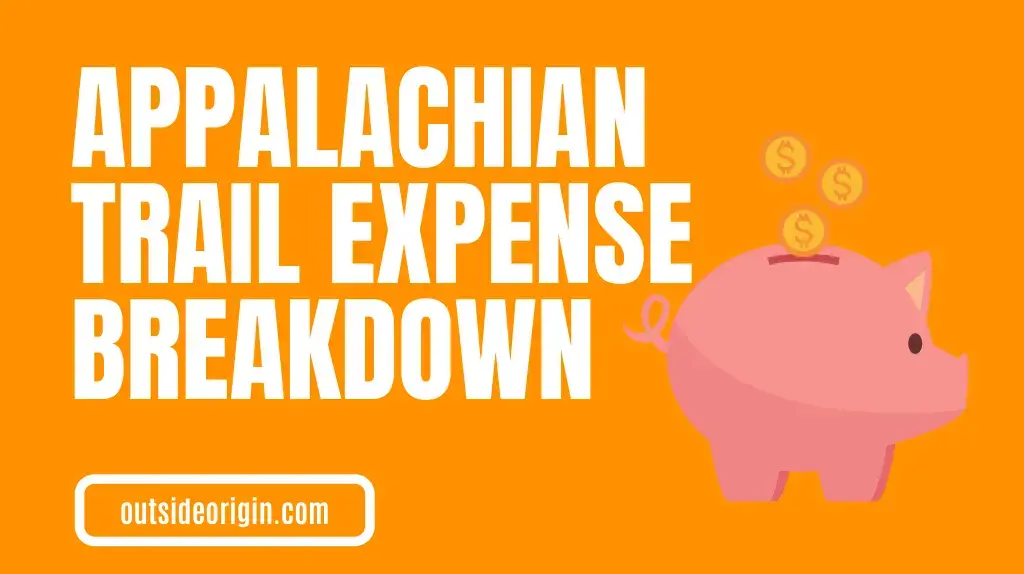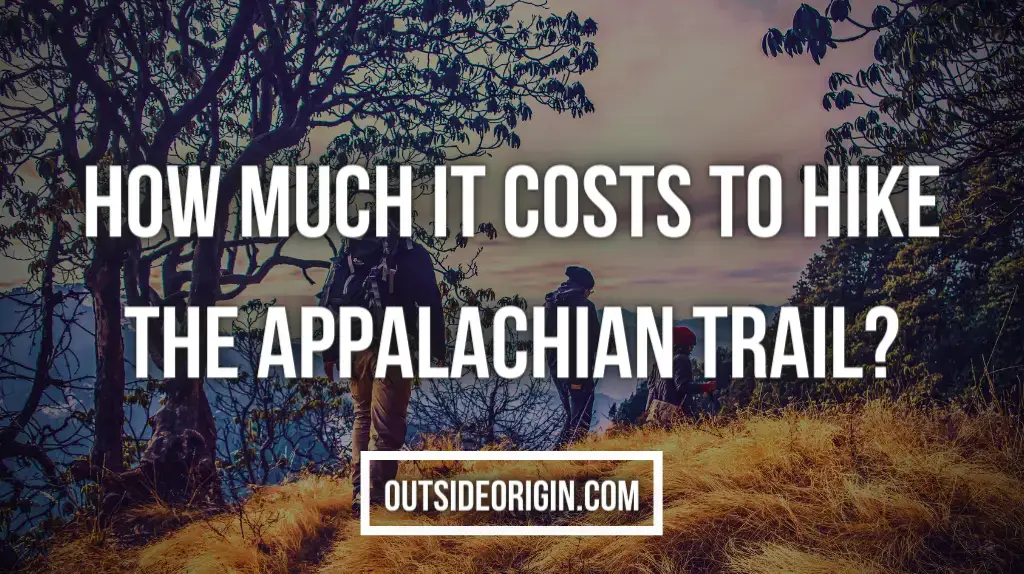The Appalachian Trail (AT) is over 2,190 miles long and travels through 14 states, eight national forests, six national park units, and several state parks, forests, and game reserves.
For many people, traversing the whole length of this national scenic path is a dream come true. And if it’s a dream come true for you, you understand the value of preparation. Creating and maintaining your Appalachian Trail budget is an important component of planning.
For thru-hikers, the Appalachian Trail costs roughly $6,000 on average. However, if you keep self-control and have a setback-free climb, you may easily spend significantly more, generally due to a lack of budgeting, or far less, usually due to a lack of budgeting.
On-trail fees, according to REI Co-op staff, may vary from $3,500 to $6,000—and that doesn’t include gear, which can cost anywhere from $700 to $5,000. The Appalachian Trail Conservancy (ATC) estimates that most hikers spend roughly $1,000 per month and take about six months to finish their journey.
Appalachian Trail Expense Breakdown

Gear: Even if you’re a seasoned traveller, you’ll almost certainly need to purchase some new or replacement gear along the trip.
Home and travel: Your recurrent costs, as well as the cost of transportation to and from the path.
Trail time: Food is your greatest expense on the trail, and it can add up quickly.
Town time: Motels, meals, and beverages pile up quickly in town.
Contingency fund: unexpected events, such as path diversions or injuries, require a contingency fund.
Reentry fund: Returning to the “real world” is difficult. Allow yourself the time and resources you require to return to work.
Gear expenses for Appalachian Trail
According to the ATC, a new set of backpacking gear costs between $1,200 and $2,000, depending on the model. It all depends on how much you already possess and what you want to upgrade to.
The most important gears and their expenses are as follows:
Sleeping bag: A three-season sleeping bag can cost anywhere from $100 for a four-pound synthetic type to over $500 for a two-pound water-resistant down variant. (You can try this one)
Tent: The majority of one-person tents cost between $140 and $400 for a four-pound tent and more than $400 for a two-pound tent. (Try out this tent)
Hiking boots or trail-running shoes: Despite the fact that trail runners or boots are not the most expensive single item of kit ($50 to $400 a pair), an average AT thru-hiker can go through four to six pairs over the course of the trek. I alternate between this and this while hiking.
Pack: The price of a pack is equivalent to that of a tent, ranging from $150 to $400. Make sure your pack is comfortable to wear and large enough to carry everything you need—most people use packs that are between 40 and 75 litres. I personally use this assault pack.
Gear tips:
- Get the greatest equipment you can afford (but figure out your budget first). You’ll want to concentrate on the big-ticket goods, as well as good rainwear.
- Maintain a light pack weight, but keep in mind that many AT hikers carry bigger packs and make it through quite fine. To go to Katahdin, you don’t need to spend a fortune on lightweight gear.
- There is a declining return on your investment after a certain point.
- The difference in quality and weight savings between a $150 sleeping bag and a $250 sleeping bag is significant.
Home and travel expenses
You won’t be able to make money on the path unless you’re really resourceful. That implies you’ll have to cover your own expenditures while you’re abroad. The following are major expenses:
- Payment for the house or rent (consider subleases) as well as utilities (like your cell phone).
- Payments on loans, such as vehicle or college loans.
- Premiums for insurance—because medical insurance is something you should absolutely factor into the expense of hiking the Appalachian Trail.
- Flights to and from the route, as well as meals, lodging, and ground transportation before and after are all included.
Appalachian Trail Trail-time expenses
Trail life is frequently less expensive than “real” life. However, six months’ worth of food and supplies may add up quickly. The average person spends between $1 and $2 per mile of the path, ranging from $2,190 to $4,380. Remember that how you pace yourself has a big impact on how much money you’ll spend. “It may sound simple, but the longer you’re on the path, the more money you’ll spend. You’ll need to account for the following:
- Meals, snacks, and beverages: Prices vary, but you don’t want to eat anything but ramen to save money. To fuel your trip, you’ll need a range of high-calorie meals and snacks.
- Resupply box shipping costs: Depending on where you reside and how often you send from home, this might be a major consideration. The majority of thru-hikers replenish in towns, owing to the fact that preferences and needs vary along the journey.
- Fuel, batteries, and other items aren’t very expensive, but they’re worth keeping track of.
Town-time expenses
Town time may be fantastic—drinks, baths, and non-dehydrated food! But it’s all too simple to go overboard. Make sure you have a spending plan in place and stick to it. Here are some of the most common offenders, as well as some strategies to save:
- Share a room in a hotel or hostel to save money.
- Restaurants: Buying prepared food from a grocery shop might help you save money.
- Alcohol: Buy it at a shop rather than at a bar, or don’t drink it at all.
- Donations: For each trail angel that hosts you, consider offering at least $20. They’ll enjoy it if you pay for their food, beds, baths, and laundry.
Even if you just visit town once a week, it adds up to 25 days over the course of a six-month trek. You’ll want to factor in a few additional days for bad weather or waiting to meet up with other hikers.
Contingency fund
If nothing unexpected happens during your hike, consider yourself quite fortunate. As a result, it’s a good idea to leave some room in your Appalachian Trail budget for those unexpected events. Perhaps you’ll have to wait for a resupply package with warmer clothes, or you’ll need to rest due to an overuse injury, or you’ll receive an unexpected wedding invitation in the middle of your journey. Some people choose a fixed sum ($1,500, for example), while others use a percentage of their income (10 percent of their overall budget).
Reentry fund
Returning to your usual life after the trial might be quite difficult. If you’re quitting your work to go hiking, save money away for a few weeks (or months) of job seeking. Even if you already have a job, taking a few weeks off helps ease the move.
How much should I budget for the Appalachian Trail?
The Appalachian Trail Conservancy advises a monthly budget of $1,000 for a thru-hiker on the Appalachian Trail. Given a five-to-seven-month average completion time, total on-trail expenses can range from $5,000 to 7,000 per participant.
What is the cheapest way to hike the Appalachian Trail?

Paying for Trail Shuttles is a waste of money. The expense of trail shuttles adds up rapidly at $1 or $2 per mile (even more than lodging.) Paying for motels or hostels is a waste of money. Mail is used to resupply.
- Purchasing food in bulk is a good idea.
- Purchase pre-owned equipment.
- Purchase clothing from a thrift store.
- Purchase multiple pairs of shoes ahead of time.
- You can also make your own equipment.
FAQs
Can you hike the Appalachian Trail for free?
The Appalachian Trail is open to the public and is free to use. Walking on the Trail does not need any fees, memberships, or permits. The A.T., on the other hand, goes through a number of state and national parks, woods, and public properties, some of which charge fees, demand permits, or require reservations to park or stay overnight in shelters or campsites.
How much money do you need to walk the Appalachian Trail?
On-trail fees, according to REI Co-op staff, may vary from $3,500 to $6,000—and that doesn’t include gear, which can cost anywhere from $700 to $5,000. The Appalachian Trail Conservancy (ATC) estimates that most hikers spend roughly $1,000 per month and take about six months to finish their journey.
Can You Do Me A Small Favor?
I have put a lot of time & effort into writing this post to provide you with the best info out there.
It’ll help me out if you could consider sharing it on your social media networks. You are also allowed to take any photo you want from my blog as long as you credit and link back!
Appreciate it! ❤️️

Hey, I am the founder of Outside Origin! I love hiking in my spare time and have gone to various different hikes. You can check out our about us section to learn more about what our team and I do over at Outside Origin.




